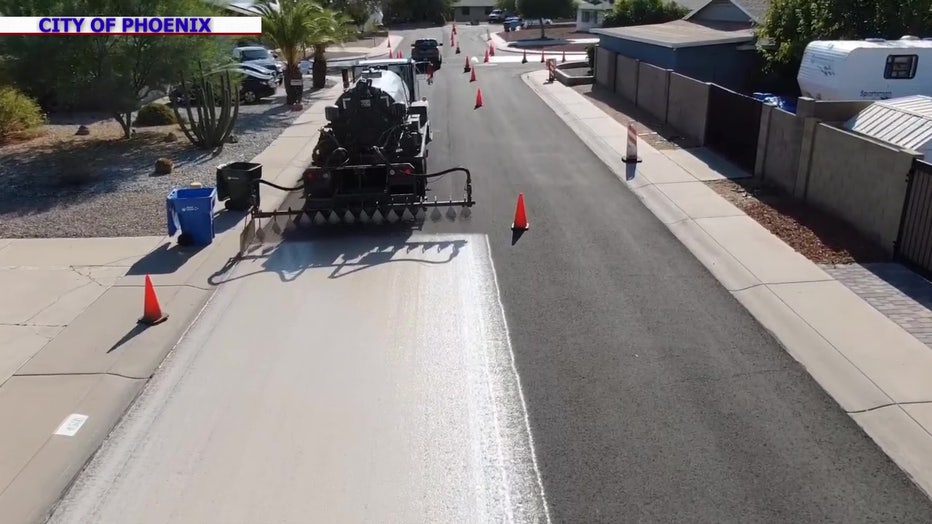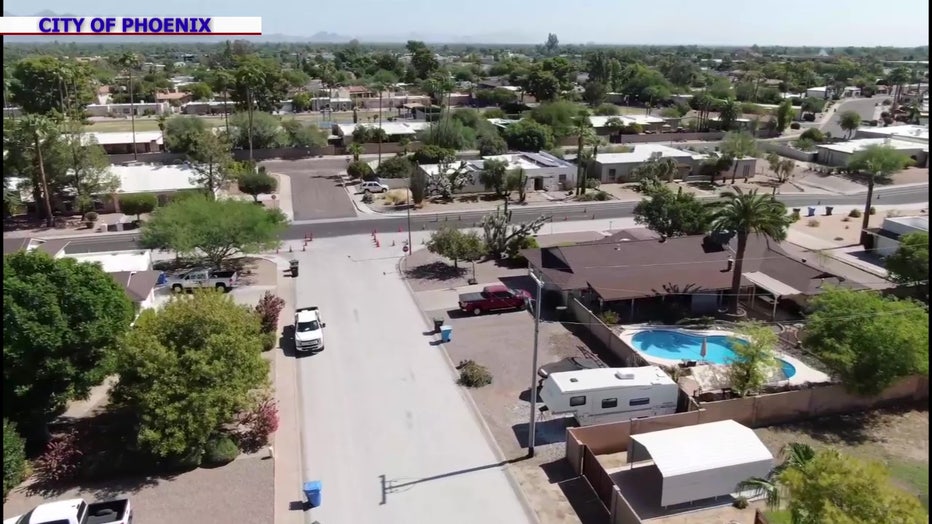Is Phoenix's 'Cool Pavement' program working? Here's what one expert is saying
PHOENIX - As temperatures across Arizona keep rising, researchers are studying ways to ease the heat island effect, and one of the ways being studied is "cool pavement."
We have reported on Phoenix's cool pavement program on various occasions since 2021, and now, an expert is weighing in on how the technology is doing.
Here's what you should know.
What is cool pavement?

In our story on the technology in 2021, we noted that cool pavement is reflective, and has a lighter color and chemical properties. It turns sunlight back toward the atmosphere rather than absorbing heat, as dark asphalt does.
At the time, it was noted that the technology has the potential to mitigate urban heat islands, save energy in buildings and reduce demand for air conditioning in buildings.
According to City of Phoenix's website, the cool pavement coating that Phoenix uses is a water-based asphalt treatment that is applied on top of an existing asphalt pavement.
The coating, according to the website, contains asphalt, water, soap (as an emulsifying agent), mineral fillers, polymers, and recycled materials.
"It contains no harmful chemicals and is compatible with traditional asphalt," read a portion of the website.
City of Phoenix had a cool pavement pilot program that ended in 2021. Since then, cool pavement has become a part of the city's street maintenance program.
What streets have cool pavements?

According to City of Phoenix's website, 100 miles of the city's streets have cool pavements, and that number is expected to rise to 118 miles by the end of 2023.
Streets with cool pavement are located throughout the City of Phoenix, according to the website.
What are Phoenix city officials saying about cool pavements?
On their website, City of Phoenix officials said cool pavements "had an average surface temperature 10.5F to 12F lower than traditional asphalt at noon and during the afternoon hours."
The website also claims when measuring nighttime air temperatures at six feet of height, the air over cool pavement is half a degree lower than non-treated surfaces.
What are experts saying about cool pavements?

Cool pavement study findings, explained
As temperatures keep rising in Arizona, researchers are looking at various ways to ease the urban heat island effect in Phoenix, and one of the solutions involves a technology known as cool pavements. FOX 10's Lindsey Ragas spoke with an ASU researchers on how the technology, which is now used on 100 miles of roadways in Phoenix, is doing.
David Sailor with Arizona State University was a research participant in ASU's study. He said for those standing in the middle of the street, the mean radiant temperature would be about 3F to 5F hotter.
Data released by the City of Phoenix also shows that "human experience of heat exposure at noon and the afternoon hours was 5.5F higher due to surface reflectivity," but also notes it is "similar to walking on a typical concrete sidewalk."
There is no significant difference that a person would feel when they are walking on the sidewalk, according to ASU's research data.
"It's more complex than saying, 'yes, you'd feel hotter with cool pavement' because the vast majority of the people in this city spend very little time walking down the middle of the street, and yet, the air temperature persists for hours each day, and so even though the air temperature benefit is relatively small, it's substantial in terms of its impact on energy use, water use and potentially health outcomes," said Sailor.
So, what can researchers say at this time about the technology?
Sailor says ASU is still researching the new technology, and weighing its pros and cons. He said there are certain places where cool pavements would work better.
"A playground is a perfect example of something that would not be a good idea," said Sailor. "A marathon route, probably not a good idea. The middle of a residential street, the air temperatures benefits throughout the day, in my mind, outweigh that 10 seconds you might be in the middle of the street."
Sailor says more research needs to still be done to understand the full benefit and consequences to cool pavement.
"The true comparison that I'd like to make is the option here is to do the seal coat with a traditional black seal coat, where you're absorbing 95% of the energy of the sun or a cool seal, a lighter color that might be similar in color, similar in reflectivity to a concrete sidewalk where it's reflecting 30% instead of 5% so 6 times as much energy is being reflected," said Sailor.
What are residents saying about cool pavements?
When we spoke with residents near 15th Avenue and Broadway Road in 2021, some were excited about the project and the prospect of making Phoenix summers more comfortable
"I think it's awesome. We need a new street anyway," one resident said.
Others, like Mario Moreno, would rather the money be spent elsewhere.
"It would have been nice if they fix the street lights and put some speed bumps," said Moreno. "I would have rather had that than the asphalt."
Are there other problems with cool pavements?

Cool pavement technology in a Phoenix neighborhood reacts to rain in an messy way
The weekend rain turned a Phoenix neighborhood?s street into a gray mushy mess. The culprit? Cool pavement coating.
In December 2022, we reported that in one area where cool pavement coating was applied, rain reacted with the pavement.
"It looked like mud," said Jenny Millinger, a resident of the neighborhood. "We walked out and the street had bubbles, and it looked a little bit like a streak of mud had been dragged down to the center of the street."
City of Phoenix officials said a different seal coat product was used in the area when cool pavement coating was reapplied. The mixture of two different products, along with rain, caused the coating to peel away.
What else is the City of Phoenix doing in terms of dealing with the heat?
In April 2022, we reported that the city has planted hundreds of threes at Cesar Chavez Park, which is located near 35th Avenue and Baseline Road in Laveen Village, with a goal to create the foundation for Phoenix's first ‘cool corridor,' providing shade and reducing the amount of heat residents have to endure.
"Trees can offer an opportunity for habitat in some places in the city, trees can be a source of food, they help cool the environment - not only by providing shade, but because water evaporates through the tree system itself," said David Hondula, Director of the Office of Heat Response and Mitigation for the city of Phoenix. "Neighborhoods that provide more trees are much cooler."
259 trees were planted along Baseline Road.
"This is an area where there are a lot of students, a lot of bus riders," said Phoenix Mayor Kate Gallego. "When the trees grow out, it's going to be shaded, much more comfortable, and a beautiful part of our city."
There are 100 cool corridors planned for the city.

